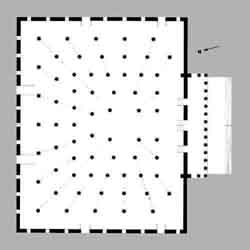|
Thersilion at Megalopolis |
Thersilion at Megalopolis
Completed in 370BC, this theatre was originally built as an assembly site for the Arcadian League. It is the largest of the three columned halls of antiquity.
Archaeological remains show that this rectangular hall stood directly to the north of one of the largest outdoor Hellenistic theatres ever built. Indeed, the two theatres were architecturally linked, with the columned porch on the hall's north fašade acting as a logeion for the outdoor theatre.
The interior of the Thersilion is unusual. The floor slopes in towards a flat, square, off-centre rostrum. This allowed roughly three-quarters of the audience to be placed in front and to the sides of the rostrum, with the remaining three-quarters to the sides and behind. However, what marks the interior out as unusual is the placement of the supporting pillars. Rather than being arranged in a grid-like fashion (see the Odeon of Pericles), the pillars were placed in rows that converged towards the rostrum (see plan). Thus, the Thersilion is distinguished as being the first large hall of antiquity where its designers attempted to reconcile the need for supporting pillars with the desire for improved sight lines.
The capacity of the Thersilion is questionable. It was known as the 'Hall of the Ten Thousand', and some scholars assert that ten thousand people, all standing, could indeed have squeezed into the building. However, it is unlikely that this capacity was often reached, especially if temporary wooden seating was used.
The Thersilion was the last of the three columned halls of antiquity to be built. Subsequent halls would be built without the need for such a complex network of supporting pillars and, ultimately, would provide clear-spanned auditoriums.

Plan of Thersilion at Megalopolis